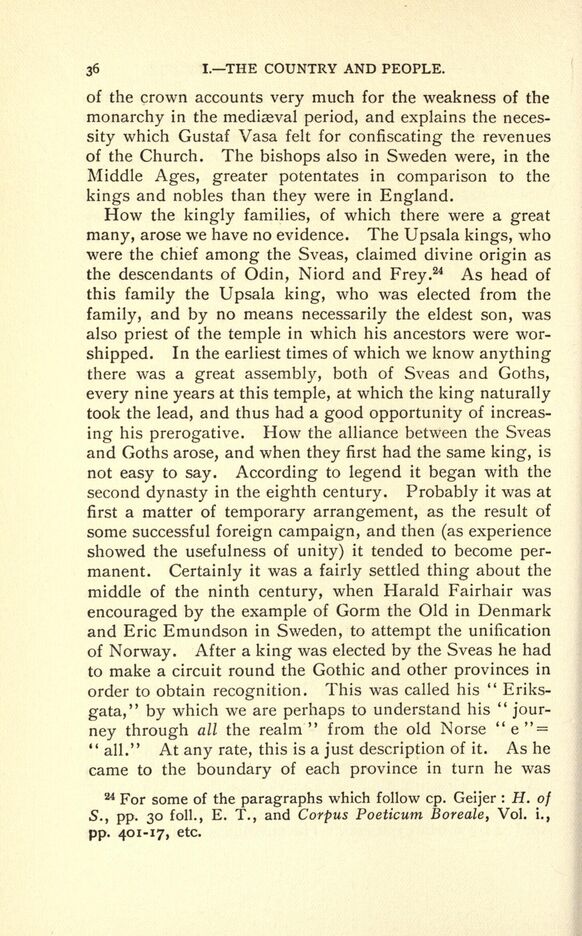
Full resolution (JPEG) - On this page / på denna sida - I. Introductory Lecture.—The Country and its Inhabitants in the Heathen Period up to 1000 A.D. - § 9. General idea of the character and life of the people

<< prev. page << föreg. sida << >> nästa sida >> next page >>
Below is the raw OCR text
from the above scanned image.
Do you see an error? Proofread the page now!
Här nedan syns maskintolkade texten från faksimilbilden ovan.
Ser du något fel? Korrekturläs sidan nu!
This page has never been proofread. / Denna sida har aldrig korrekturlästs.
36 I. THE COUNTRY AND PEOPLE.
of the crown accounts very much for the weakness of the
monarchy in the mediaeval period, and explains the neces
sity which Gustaf Vasa felt for confiscating the revenues
of the Church. The bishops also in Sweden were, in the
Middle Ages, greater potentates in comparison to the
kings and nobles than they were in England.
How the kingly families, of which there were a great
many, arose we have no evidence. The Upsala kings, who
were the chief among the Sveas, claimed divine origin as
the descendants of Odin, Niord and Frey.
24
As head of
this family the Upsala king, who was elected from the
family, and by no means necessarily the eldest son, was
also priest of the temple in which his ancestors were wor
shipped. In the earliest times of which we know anything
there was a great assembly, both of Sveas and Goths,
every nine years at this temple, at which the king naturally
took the lead, and thus had a good opportunity of increas
ing his prerogative. How the alliance between the Sveas
and Goths arose, and when they first had the same king, is
not easy to say. According to legend it began with the
second dynasty in the eighth century. Probably it was at
first a matter of temporary arrangement, as the result of
some successful foreign campaign, and then (as experience
showed the usefulness of unity) it tended to become per
manent. Certainly it was a fairly settled thing about the
middle of the ninth century, when Harald Fairhair was
encouraged by the example of Gorm the Old in Denmark
and Eric Emundson in Sweden, to attempt the unification
of Norway. After a king was elected by the Sveas he had
to make a circuit round the Gothic and other provinces in
order to obtain recognition. This was called his
"
Eriks-
gata," by which we are perhaps to understand his
"
jour
ney through all the realm" from the old Norse "e"
=
"
all." At any rate, this is a just description of it. As he
came to the boundary of each province in turn he was
24
For some of the paragraphs which follow cp. Geijer : H. of
5., pp. 30 foil., E. T., and Corpus Poeticum Boreale, Vol. i.,
pp. 401-17, etc.
<< prev. page << föreg. sida << >> nästa sida >> next page >>